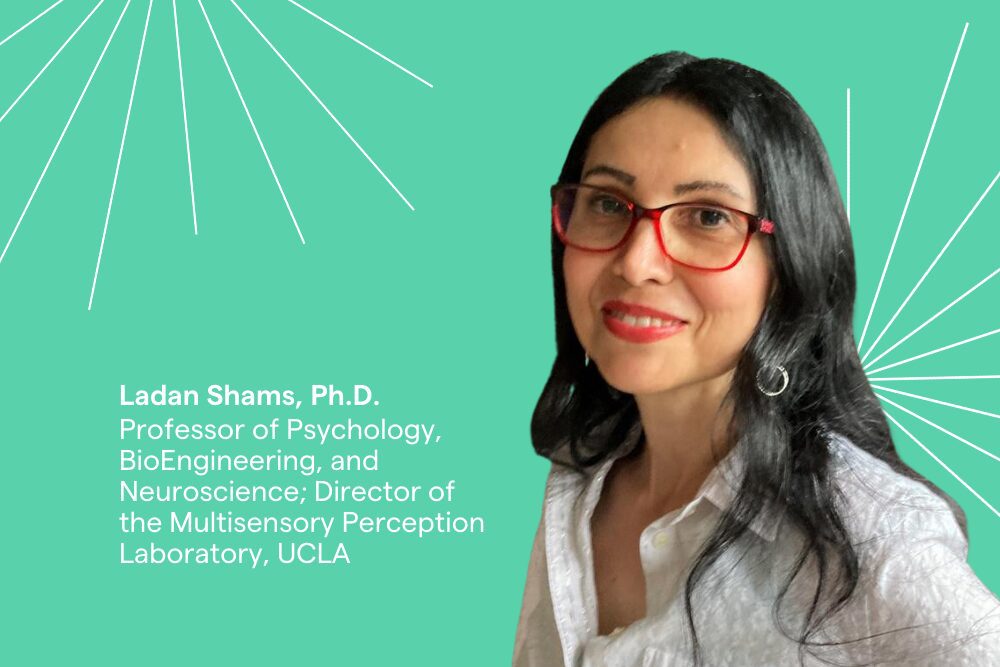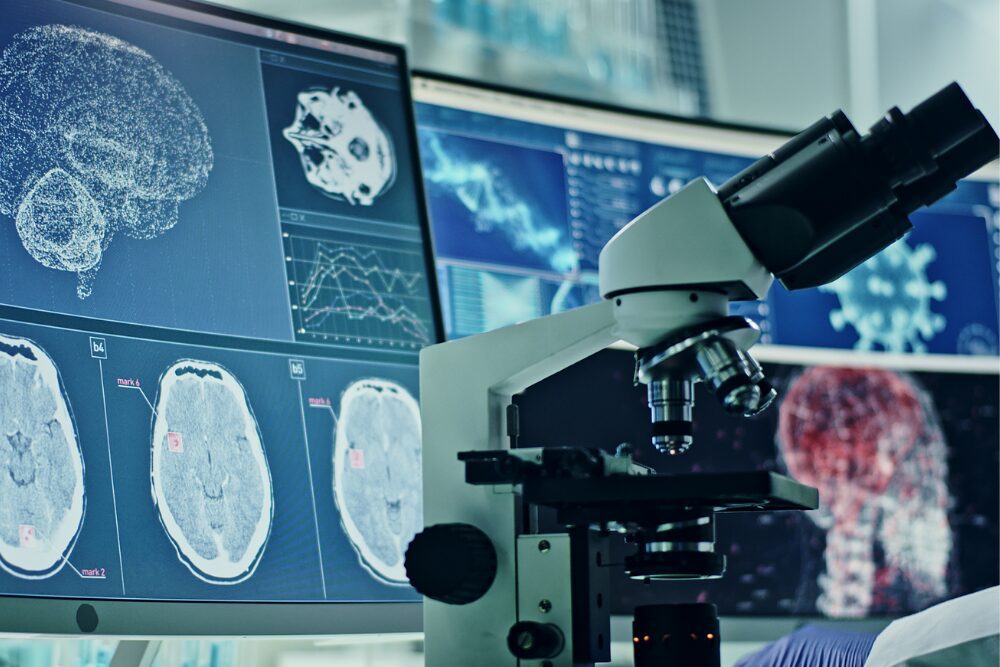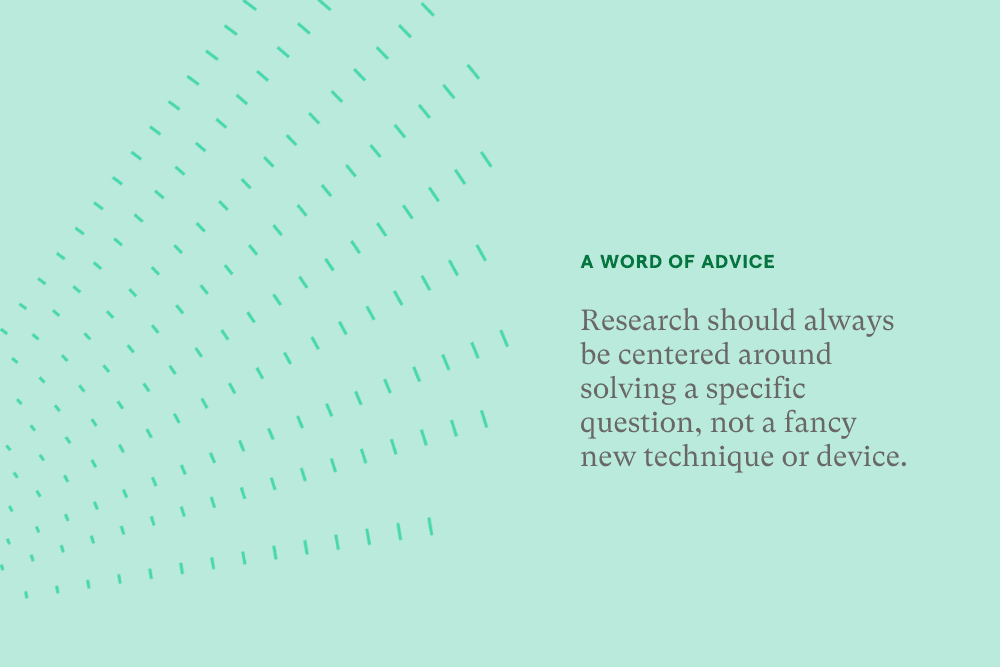June 29, 2022
Member Spotlight: Multisensory Processing Lab at UCLA

UCLA’s Multisensory Processing Lab is Unlocking How Our Brains Work and Developing a Tool to Identify Early Signs of Cognitive Decline
June is Alzheimer’s and Brain Awareness Month, and this month we are featuring Ladan Shams, a multi-hyphenate expert when it comes to what’s going on in our minds. Shams earned a Ph.D. in computer science, completed postdoctoral training in cognitive neuroscience, and has published more than 80 articles and book chapters. A professor of psychology, bioengineering, and neuroscience at UCLA, she is the director of the university’s Multisensory Processing Lab, which studies how the brain integrates information from different sensory modalities—ways the senses affect our memory, how we learn, and how our preferences are shaped. Shams is a go-to expert for the media including outlets like ESPN, which consulted her on why NFL wide receivers select certain jersey numbers and how the brain may associate numbers with appearance, mass, and speed. Shams’s laboratory is developing an invention—currently called “A Behavioral Method of Cognitive Assessment, Training and Cognitive Decline Remediation”—that may better identify early signs of cognitive decline. It’s an assessment that people can take online and on-the-go in a few minutes, and as both a diagnostic and treatment tool could possibly help patients proactively identify and address conditions such as dementia and Alzheimer’s. Shams pursued developing the invention when she accidentally made an impactful discovery while studying memory.
Can you tell us about the invention and how it works?
This invention is about how some of our recent findings may be useful for developing diagnostic and therapeutic approaches to assessing cognition and cognitive decline at an early stage, and also in developing a strategy for training and remediating cognitive decline and dementia. It’s done using a very simple and convenient method that can be implemented on a mobile device—like a cell phone, tablet, or a desktop—and can be done anywhere. For that reason, it makes it very easy for people who are reaching an age, like me [laughs] who starts worrying about these things.
Even if everything seems okay, or if you are just curious, you can easily monitor your cognition and how things are going in your brain. Do this repeatedly—based on your needs, maybe once every month, or even just once a year. That way, you can track your cognitive abilities and how they change over time. If you notice your score is steadily going down, then you can be seen [by a clinician] to get a more detailed assessment and possibly have some imaging done.
In addition to being very useful for ordinary people to keep track of their cognitive abilities, it [the invention] can also be one of the tools that clinicians use as part of the assessment they perform. It’s particularly helpful because it has the potential to detect anomalies and red flags early on. If cognitive decline is detected early, there may be interventions that can help, but if it’s detected late, it may be too late. For that reason, the assessment and diagnostics aspect of it is very exciting. But the other side of the coin is the therapeutic aspect of it: it has the potential to have an easy to implement, inexpensive intervention that can be done by people at home. They don’t have to go to the clinic every time. They can do it whenever they have time.

Many of us (including myself) have lost our loved ones to Alzheimer’s or other brain diseases. Alzheimer’s and other dementias have become public health issues and require the public’s attention, awareness and engagement to be addressed effectively and swiftly.
How does your invention differ from existing cognitive training apps and websites?
Unfortunately, those programs have not been very effective overall. The domain of improvement is very specific to what you train on the specific app, to the specific task. It doesn’t seem to generalize to other apps or tasks on the computer, let alone to daily life and daily function.
What our approach offers is something that actually has the potential to generalize to other tasks and also to daily life function, because it’s a very foundational ability, a process in the brain that basically feeds into a lot of other things that we rely on in our daily lives. So if we strengthen that pillar, the foundation, then everything else that is standing on it will benefit as a result—that’s the therapeutic aspect of it.
What kind of anomalies does the invention look for?
Right now, if you go to a neurologist and they test you, there are some tests [commonly used] that are relatively fast, like the Montreal Cognitive Assessment (MOCA). It can be done in a few minutes and is very simple. But the problem is that it’s not very sensitive to small declines. So you have to have already suffered significant deterioration in processing for that test to show something. Our test has a potential to detect smaller deterioration or decline, and because it correlates with a lot of high-level functions it can serve as a useful initial test. If the result is not very good, then you can say, ‘Oh, that’s a red flag: maybe we should take a closer look and do more extensive neuropsychological and/or medical tests.’

What stages are the technology and invention at right now?
We have a lot of data; nothing has been published yet. We have very compelling results that show the relationship between scores on low-level tasks and high-level cognitive abilities. We need to collect more data in older populations and patient populations. For the training, we have some results—they’re not at a stage where they can be published yet, but they suggest that the training protocol that we have developed is effective.
How long has this project been in the making?
This is really new: less than two years old. It started with something we found accidentally [laughs]. We discovered a robust relationship between high-level cognition and a very low-level processing task; something I had not expected at all, and found astonishing. I decided to explore that relationship both in depth and breadth to explore the strength, robustness, and specificity of it. All of these questions are important with respect to translational applications.
The finding was exciting because it opened the avenue for both: using a simple easy-to-use test as an assessment tool for early detection of cognitive decline; and perhaps more importantly, a target for training to induce improvement in cognition and memory. Both early detection and therapeutic intervention can make a significant difference in outcome for those at risk for cognitive decline and dementia.

What is an example of low-level brain function? Why are they measured in your assessment, and why is it important that it is tested?
In general, tasks that the sensory systems continuously perform in the brain (such as detecting or localizing or discriminating different sensory events like lights or sounds or touches, etc.) are considered low levels of processing in the brain. Our brains are evolved to perform these tasks, often without even a need for awareness or attention. This is in contrast to tasks like playing chess, speaking, problem solving, reasoning, remembering a poem, and so on which are considered high-level function.
People make workarounds for higher brain functions and compensate when they decline. This is one issue with neuropsychological evaluations. If you ask someone how often they forget things, even if they have experienced cognitive decline, people are extremely good at developing coping strategies. For example, if I’m getting bad at remembering names, I’ll know how to look up people’s names using Google—I’ll develop a system to get around that shortcoming so it won’t affect my day-to-day life. And for some people who are on their way to developing Alzheimer’s, decline may not show up on tests until it’s too late because people develop coping mechanisms.
However, developing a coping strategy for a low-level function is not possible. Even if you tried, you couldn’t do it. For that reason, it can be a more sensitive measure of cognitive ability.
What is your biggest challenge right now with this project?
We are currently exploring three different approaches to training, trying to develop easy-to-use and efficient training methods and protocols. In the next stage, the biggest challenge will be collecting real-world data from patient groups to evaluate the rate of adoption of these tools by individuals, the effectiveness of assessment in clinical settings, and effectiveness of training in daily life function of patients.
What does Alzheimer’s and Brain Health Awareness Month mean to you, and why is public awareness of brain health important?
Many of us (including myself) have lost our loved ones to Alzheimer’s or other brain diseases. Alzheimer’s and other dementias have become public health issues and require the public’s attention, awareness and engagement to be addressed effectively and swiftly. Any of us can be affected by brain disease, either as the person suffering it or as the person giving care to someone suffering it. And none of us wish our children to be burdened either way. The public can contribute to the solution by engaging in preventive measures, and by demanding policy makers to fund brain research and to implement preventative measures, infrastructure, as well as regulations to improve health and healthcare.
Lastly, what advice do you have for young life scientists?
Given the fast development of new sophisticated technologies, it has become very easy for young life scientists to become impressed and distracted by fancy techniques; and to focus their talents and energy on pursuit of learning new flashy techniques. This can, unfortunately, be at the expense of losing sight of important scientific questions, which more frequently than not require creativity and insight to be addressed, rather than application of cutting-edge technologies. Research techniques are the means and not the end. Start by asking the right question, and pursue a research program that is centered around an important scientific question, and not a flashy technique.